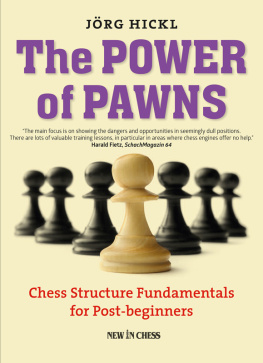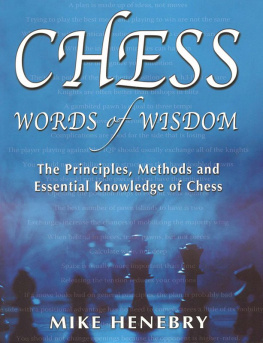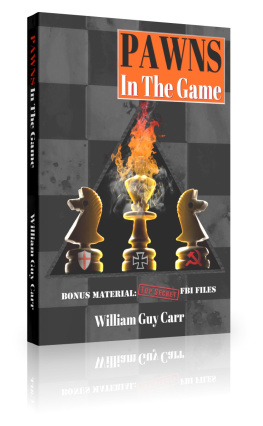Jorg Hickl - The Power of Pawns
Here you can read online Jorg Hickl - The Power of Pawns full text of the book (entire story) in english for free. Download pdf and epub, get meaning, cover and reviews about this ebook. publisher: New in Chess, genre: Art. Description of the work, (preface) as well as reviews are available. Best literature library LitArk.com created for fans of good reading and offers a wide selection of genres:
Romance novel
Science fiction
Adventure
Detective
Science
History
Home and family
Prose
Art
Politics
Computer
Non-fiction
Religion
Business
Children
Humor
Choose a favorite category and find really read worthwhile books. Enjoy immersion in the world of imagination, feel the emotions of the characters or learn something new for yourself, make an fascinating discovery.
- Book:The Power of Pawns
- Author:
- Publisher:New in Chess
- Genre:
- Rating:3 / 5
- Favourites:Add to favourites
- Your mark:
- 60
- 1
- 2
- 3
- 4
- 5
The Power of Pawns: summary, description and annotation
We offer to read an annotation, description, summary or preface (depends on what the author of the book "The Power of Pawns" wrote himself). If you haven't found the necessary information about the book — write in the comments, we will try to find it.
The Power of Pawns — read online for free the complete book (whole text) full work
Below is the text of the book, divided by pages. System saving the place of the last page read, allows you to conveniently read the book "The Power of Pawns" online for free, without having to search again every time where you left off. Put a bookmark, and you can go to the page where you finished reading at any time.
Font size:
Interval:
Bookmark:
The Power of Pawns
Jrg Hickl
The Power of Pawns
Chess Structure Fundamentals for Post-beginners
New In Chess 2016
2016 New In Chess
Published by New In Chess, Alkmaar, The Netherlands
www.newinchess.com
All rights reserved. No part of this book may be reproduced, stored in a retrieval system or transmitted in any form or by any means, electronic, mechanical, photocopying, recording or otherwise, without the prior written permission from the publisher.
Cover design: Volken Beck
Translation: Ian Adams
Supervisor: Peter Boel
Proofreading: Frank Erwich
Production: Anton Schermer
Have you found any errors in this book?
Please send your remarks to and implement them in a possible next edition.
ISBN: 978-90-5691-631-2
Explanation of Symbols
The chessboard with its coordinates:

 White to move
White to move
 Black to move
Black to move
King
Queen
Rook
Bishop
Knight
! good move
!! excellent move
? bad move
?? blunder
!? interesting move
?! dubious move
 White stands slightly better
White stands slightly better
 Black stands slightly better
Black stands slightly better
 White stands better
White stands better
 Black stands better
Black stands better
+ White has a decisive advantage
+ Black has a decisive advantage
= balanced position
unclear
 counterplay
counterplay
 compensation
compensation
# mate
corr. correspondence
jr junior
sr senior
Introduction
What every club player desires is to reach an acceptable playing level with a reasonable expenditure of time and effort. That is the point of the present book The power of the pawns. An overview of basic pawn structures, together with a lot of practical hints, helps to improve ones understanding of chess at a deep level.
Chess players require a broad spectrum of knowledge. A game seldom works out as planned new, frequently unknown positions suddenly crop up and demand great flexibility. One has to transform experience into a positional evaluation which is as accurate as possible. Profound knowledge is of course an advantage, but frequently unnecessary. This book is intended to make a contribution to turning a club player into an all-rounder, who can feel at home in any situation. It is important to recognise the strengths and weaknesses of a pawn structure, in order to bring their advantages to bear in practice. The study of this volume will help you with that.
In the middle of the 90s, when in addition to top-level sport I focussed more of my chess activity on the organisation of chess holidays and chess training, the needs of the majority of club players were foreign to me. The demands of top-level chess are too different from those of occasional tournament players. In more than ten years of intensive work and communication with the participants in my holidays, the same questions about structures and evaluation of positions kept coming up. I became aware that club players have to struggle with a similar approach and similar problems.
These reflections led among others to the following questions: Can I do something to improve this situation? Where can my experience help to make learning easier for chess players? And how can they make progress?
During my training I kept having my attention drawn to the difficulties participants had with pawn structures and the related evaluation of positions. Pawns are the soul of the game this was already recognised by Franois-Andr Danican Philidor, the worlds best player in the 18th century. Their particular way of moving is of decisive significance: they are the only pieces which cannot move backwards. A careless pawn move can have important consequences, which can be seen with subjects such as the good/bad bishop, the open file or the eternal piece.
To clarify these specific effects on the other pieces, the introductory part of the book is dedicated to the minor pieces and the rooks. Those pieces which move both in straight lines and diagonally, the king and the queen, are far less dependent on the structure and thus are not considered separately.
There are many typical pawn structures too many. Even for experienced grandmasters their study involves lifelong learning. No single book can provide an exhaustive treatment and would in any case demand too much of the student. So the main part is limited to the most frequently met and basic structures: from hanging pawns via isolated pawns to weak squares.
Working with this book
It is not sufficient to read chess books. Their contents must be studied intensively and worked through, so as to consolidate the knowledge in a lasting manner. This demands a certain amount of personal initiative and unfortunately also a not inconsiderable investment of time. That, however, is the only way in which the knowledge can be assimilated and also recalled without problem at a later date in order to be of use in your own games.
Every structure dealt with in the second part is first explained in general terms by means of a diagram. In order to lay the accent on their particularities, no pieces have been included in certain circumstances, however, not a single piece has yet left the board. All the structures of course can occur with reversed colours.
Basically you should be working with a chessboard of tournament dimensions! Through their practice chess players are very strongly influenced by threedimensional thinking and achieve noticeably better results at the board than they do when working with a chess program or a computer monitor.
Important positions are highlighted by diagrams and provided with an exercise. Solving these will be easier for you if in doing so you answer the following questions:
- What are the specific characteristics of the position? Pay attention to different pawn majorities, king safety and important peculiarities concerning the minor pieces, like for example good or bad bishops or eternal squares for pieces.
- Where should I play? Queenside, kingside, or the centre?
- Are different evaluations valid for different phases of the game? Should you neglect in the opening or middlegame a pawn weakness, which will constitute a serious defect in the endgame?
- Where are there pawn levers? Is there a possibility of altering the structure? By advancing my own pawn, can I open a line or create a weakness?
And never forget an extremely important point:
- What are the opponents intentions? If you can answer this question then you are one step ahead of him!
But The Power of the Pawns does not just offer an overview of various structures. In many places you will find, in italics, practical tips, e.g. how to behave in time trouble, finding candidate moves and classic mistakes.
Independent study of the model games listed at the end of each chapter will round off the subject matter and deepen the knowledge you have acquired. All the games mentioned in the book are available on the internet in electronic form for a free download at www.joerg-hickl.de.
Next pageFont size:
Interval:
Bookmark:
Similar books «The Power of Pawns»
Look at similar books to The Power of Pawns. We have selected literature similar in name and meaning in the hope of providing readers with more options to find new, interesting, not yet read works.
Discussion, reviews of the book The Power of Pawns and just readers' own opinions. Leave your comments, write what you think about the work, its meaning or the main characters. Specify what exactly you liked and what you didn't like, and why you think so.












